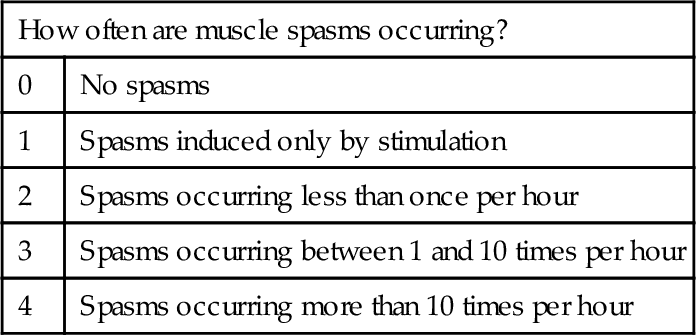CHAPTER 153
Spasticity
Joel E. Frontera, MD; Monica Verduzco-Gutierrez, MD
Definition
Spasticity is commonly defined as a velocity-dependent increase in muscle tone with exaggerated tendon jerks, resulting from hyperexcitability of the stretch reflex. This means that the faster the passive movement of the limb through its range, the greater the increase in muscle tone. This definition makes spasticity a component of an upper motor neuron syndrome, which is also associated with other findings that include hyperreflexia, clonus, muscle co-contraction, and muscle weakness.
Spasticity can be caused by a variety of upper motor neuron conditions. It is often noted to be a major problem in conditions like spinal cord injury, multiple sclerosis, and traumatic brain injury. It is estimated to affect between 40% and 80% of patients with a spinal cord injury or multiple sclerosis and as much as 80% of the traumatic brain injury population. It can also be present in other conditions like amyotrophic lateral sclerosis, brain and spinal cord tumors, and cerebral palsy.
Symptoms
Patients may complain of increased tightness, worsening spasms, and pain when they come to the clinic, but more important, the main complaint can be worsening of functional activities. The ability to move affected limbs actively or passively is reduced. Spasticity significantly interferes with routine tasks and even hygiene (e.g., increased elbow flexor spasticity in a stroke survivor while walking; adductor spasticity in a paraplegic individual during urinary catheterization) while at the same time causing pain and muscle co-contraction. These symptoms may be due to a secondary condition that may increase spasticity, such as an infectious process, skin problems, and cord tethering. Thus, when a patient comes to the clinic complaining of worsening spasticity, a thorough history and physical examination should be performed to identify the cause.
Physical Examination
Spasticity occurs in the presence of other signs and symptoms of upper motor neuron damage. Other positive signs include hyperreflexia, Babinski responses, and clonus. Negatives signs include muscle weakness, fatigue, reduced motor control, and loss of coordination. Increased muscle tone in the absence of these findings should lead to consideration of alternative causes of increased muscle tone, such as dystonia, Parkinson disease, or pain-associated muscle spasm. Strength testing may not be reliable as the spasticity may affect both range of motion because of contractures and co-contraction of antagonist muscles.
Muscle contracture as well as other soft tissue changes can be a part of this upper motor neuron syndrome, and it may be difficult in some cases to determine how much contracture is present in an individual with severe spasticity. A thorough physical examination can discover other issues associated with spasticity that could affect the individual, such as sensory disturbances (proprioception and spatial orientation), dysphagia, dysarthria, and skin issues. The skin should be inspected because abnormal positioning due to spasticity may directly cause skin injury (e.g., maceration of the palm due to a clenched fist) or contribute to pressure ulcer formation.
Sometimes it is important to differentiate spasticity from rigidity, commonly seen in conditions like Parkinson disease. One must look at some physical examination findings that occur with spasticity, such as the clasp-knife phenomenon. There is also variability when antagonistic muscles are evaluated. In spasticity, for example, some muscle groups are more affected than their antagonist muscles. Rigidity is not velocity dependent; it is constant throughout the full range of motion.
Functional Limitations
Spasticity can cause significant functional limitations. In a patient with spinal cord injury, for example, spasticity can have a serious impact on positioning. It can affect wheelchair positioning as well as transfers. Hygiene and catheterization may be affected by significant hip adductor tone or spasticity. It will affect dexterity and fine motor coordination in the upper extremities. The use of bracing or other modalities to assist with ambulation may be limited if the spasticity is significant. Studies have found that a significant number of patients with both spinal cord injury and traumatic brain injury have noted that spasticity affects quality of life. In some cases, spasticity may serve as a partial substitute for voluntary muscle contraction. A common example of substitution for voluntary muscle function is the hip and knee extensor spasticity seen after stroke that may allow successful weight bearing through the weak leg and contribute to restoration of walking ability.
Diagnostic Studies
Spasticity is a clinical diagnosis, without any specific laboratory confirmation. Clinical measurement scales to quantify the severity of spasticity may be useful to monitor the efficacy of treatment. The most commonly used scales are the Ashworth scale (and a modified version of this scale) [1], which measures resistance of the muscle to passive stretch, and the Penn Spasm Frequency scale, which characterizes the frequency of muscle spasms [2] (Tables 153.1 and 153.2).
Table 153.1
Modified Ashworth Scale [1]
| 0 | No increase in muscle tone |
| 1 | Slight increase in muscle tone, manifested by a catch and release or by minimal resistance at the end range of motion when the part is moved in flexion or extension/abduction or adduction |
| 1+ | Slight increase in muscle tone, manifested by a catch, followed by minimal resistance throughout the remainder (less than half) of the range of motion |
| 2 | More marked increase in muscle tone through most of the range of motion, but the affected part is easily moved |
| 3 | Considerable increase in muscle tone, passive movement is difficult |
| 4 | Affected part is rigid in flexion or extension (abduction or adduction) |








